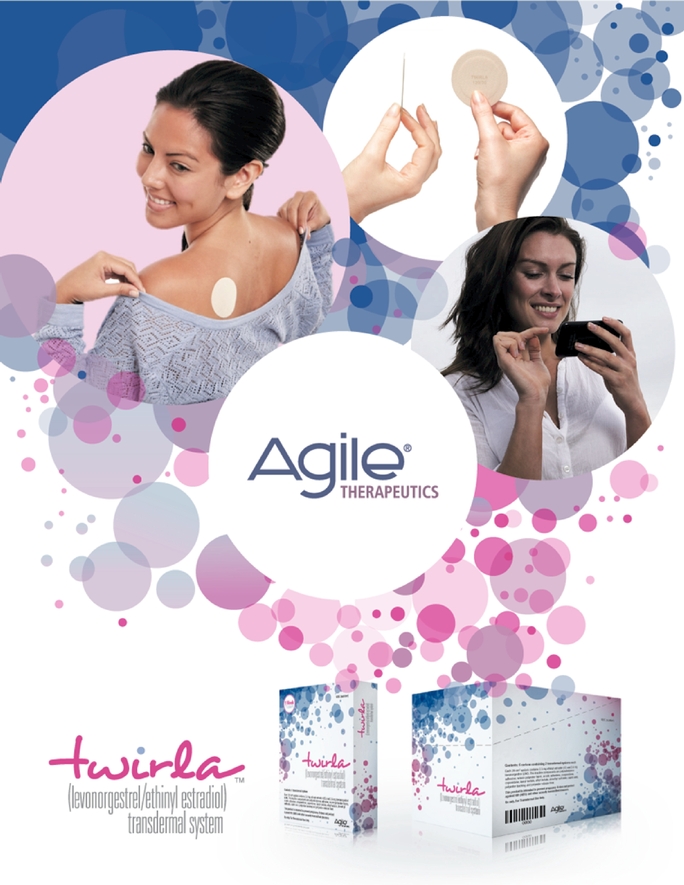
What is Twirla?
Twirla is a new contraceptive patch designed for patients who want freedom from the daily pill without committing to a longer acting method. This transdermal patch delivers 120mcg of levonorgestrel and 30mcg of ethinyl estradiol through Agile’s Skinfusion® patch, which consists of five layers and serve as the reservoir for the active and inactive ingredients, as well as a barrier to prevent accumulation of debris from daily wear. Twirla is designed to be applied once weekly for three weeks, followed by one patch free week for menstruation.
Currently there is only one hormonal contraceptive patch available for consumer use called Xulane (norelgestromin 150mcg/ethinyl estradiol 35mcg). Women who use this patch have higher blood serum concentrations of estrogen compared to oral methods (AUC0-∞ 37.7±5.6 vs. 22.7±2.8), which is associated with health concerns such as increased risk of blood clots in the legs and lungs. Agile Therapeutics, the women’s healthcare company behind Twirla, saw an unmet need in the market for a low-dose hormonal contraceptive patch. This market gap lead to the development of their newly formulated contraceptive patch, Twirla.
What are the pros and cons of Twirla?
This patch provides another option for women who desire an alternative from a daily pill, without the constraints of a longer acting method. Twirla is applied once weekly, meaning women only have to remember their birth control about three times a month rather than every day. With various daily activities and responsibilities, a weekly patch liberates women from one of those daily routines. There are other birth control options such as the Depo-Provera injection, IUDs, or implants that serve as alternatives to the pill but some women perceive these methods as more invasive compared to the patch. Additionally, given the lower dose of estrogen, Twirla appears to have a lower risk of blood clots as shown in comparator studies but remains equally effective in regulating menstrual cycles and preventing pregnancies as compared to the existing patch option.
Although the convenience of a patch is desirable, there are several noteworthy considerations with this product. As previously mentioned, Twirla’s formulation lowers the risk of blood clots, but there remains a risk of blood clots with hormonal patches compared to oral methods. Additional side effects reported with Twirla include unscheduled vaginal bleeding, weight gain, headache, and abdominal cramps. Women have also reported skin irritation when applying and removing the patch. Regarding size, Twirla is round and slightly larger (28cm2) than the Xulane (14 cm²) patch. Additionally, both Twirla and Xulane are currently only produced in one neutral shade of beige. For many women, this prevents the possibility of a discrete form of birth control which may make this a less desirable option.
Are there different considerations with a patch compared to other contraceptive methods?
Given the hormones in Twirla, the patch works just like the pill in terms of preventing pregnancy by delaying ovulation. It can be applied on the upper arm, buttocks, back, or lower abdomen. The patch is designed to withstand activities such as exercising, swimming, showering, etc. If the patch does happen to fall off during the week, it can be reapplied or a new patch may be used in its place. If the patch has been off more than 24 hours, a back up method such as condoms should be used for the next seven days of the new patch cycle. Although it’s rare (<2% of the time), healthcare providers recommend daily checks to ensure the patch has not accidentally fallen off. Patches should not be worn longer than the week they are intended and consequences of doing so include bleeding, spotting, and increased risk for unintended pregnancy. If a patient is more than 48 hours late transitioning from the existing patch to a new patch, then a back up should be used for seven days. Like all other birth control methods, Twirla does not protect against sexually transmitted diseases or HIV.
Is Twirla a good option for everyone?
There is no one-size fits all method that is right for all women. Some women might be at greater risk for adverse effects with the patch. Agile reported reduced efficacy in preventing pregnancy for women who weigh 202 pounds (92kg) or more, or who have a BMI of 30 kg/m2 or greater. As a result, the drug company initially issued a Limitation of Usestatement in their product labeling that documented this clinical outcome. Since gaining FDA approval, this limitation has transitioned to a listed contraindication. Xulane’s package insert lists the same contraindication, yet is regularly prescribed in women with a BMI >30 kg/m2. Studies have shown that the decrease in efficacy does not preclude the use of these patches in obese women. To combat the associated risks, additional counseling to emphasize the importance of strict compliance with the patch for optimal protection is necessary. Studies have also shown an increased risk in blood clots in women who are overweight and those who smoke. Additional contraindications for using Twirla include women with a high risk of thrombotic disease, who experience migraine with aura, who have liver disease, or who have undiagnosed abnormal uterine bleeding.
Is Twirla available now?
Twirla was approved by the FDA earlier this month on February 14, 2020. As part of the approval process, the FDA is requiring Agile to conduct a long term, observational post-marketing study to further evaluate the risks of blood clots in new users of Twirla. With its recent approval, the manufacturer is now focusing their attention on commercializing Twirla for consumer use. They hope to complete the manufacturing process and expect to ship the initial product to wholesalers as early as the end of this year.
With patient needs and safety in mind, the approval of this medication further expands the range of contraceptive options available for women. Given that there have only been three non-daily combined hormonal contraceptive methods made available since 2001, this is a valuable and timely option for women who seek alternative methods.
References
- FDA Approves Agile Therapeutics, Inc.’s Twirla® (levonorgestrel and ethinyl estradiol) Transdermal System – A New Weekly Contraceptive Patch Delivering a 30 mcg Daily Dose of Estrogen and 120 mcg Daily Dose of Progestin. (2020, February 14). Retrieved February 23, 2020, from https://ir.agiletherapeutics.com/news-releases/news-release-details/fda-approves-agile-therapeutics-incs-twirlar-levonorgestrel-and
- Efficacy, Safety and Tolerability Study of Agile AG200-15 Transdermal Contraceptive Delivery System – Full Text View. (2017, September 25). Retrieved from https://clinicaltrials.gov/ct2/show/NCT02158572?term=AG200-15&draw=2&rank=1
- Therapeutics, A. (n.d.). Results From the SECURE Trial, a Phase 3 Study of the… : Obstetrics & Gynecology. Retrieved from https://journals.lww.com/greenjournal/Abstract/2017/05001/Results_From_the_SECURE_Trial,_a_Phase_3_Study_of.46.aspx
- Hatcher, R. A. et. al (2018). Contraceptive technology. New York, NY: Ayer Company Publishers, Inc.
- Van den Heuvel et. al, M. W. (2005). Comparison of ethinylestradiol pharmacokinetics in three hormonal contraceptive formulations: the vaginal ring, the transdermal patch and an oral contraceptive. Contraception, 72(3). Retrieved from https://www-sciencedirect-com.proxy-remote.galib.uga.edu/science/article/pii/S0010782405000971
About the Author
Savannah Gross is a third-year pharmacy student at the University of Georgia College of Pharmacy.
Article reviewed by Rebecca Stone, PharmD, BCPS, BCACP
